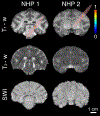A Clinical System for Non-invasive Blood-Brain Barrier Opening Using a Neuronavigation-Guided Single-Element Focused Ultrasound Transducer
- PMID: 31668690
- PMCID: PMC6879801
- DOI: 10.1016/j.ultrasmedbio.2019.09.010
A Clinical System for Non-invasive Blood-Brain Barrier Opening Using a Neuronavigation-Guided Single-Element Focused Ultrasound Transducer
Abstract
Focused ultrasound (FUS)-mediated blood-brain barrier (BBB) opening is currently being investigated in clinical trials. Here, we describe a portable clinical system with a therapeutic transducer suitable for humans, which eliminates the need for in-line magnetic resonance imaging (MRI) guidance. A neuronavigation-guided 0.25-MHz single-element FUS transducer was developed for non-invasive clinical BBB opening. Numerical simulations and experiments were performed to determine the characteristics of the FUS beam within a human skull. We also validated the feasibility of BBB opening obtained with this system in two non-human primates using U.S. Food and Drug Administration (FDA)-approved treatment parameters. Ultrasound propagation through a human skull fragment caused 44.4 ± 1% pressure attenuation at a normal incidence angle, while the focal size decreased by 3.3 ± 1.4% and 3.9 ± 1.8% along the lateral and axial dimension, respectively. Measured lateral and axial shifts were 0.5 ± 0.4 mm and 2.1 ± 1.1 mm, while simulated shifts were 0.1 ± 0.2 mm and 6.1 ± 2.4 mm, respectively. A 1.5-MHz passive cavitation detector transcranially detected cavitation signals of Definity microbubbles flowing through a vessel-mimicking phantom. T1-weighted MRI confirmed a 153 ± 5.5 mm3 BBB opening in two non-human primates at a mechanical index of 0.4, using Definity microbubbles at the FDA-approved dose for imaging applications, without edema or hemorrhage. In conclusion, we developed a portable system for non-invasive BBB opening in humans, which can be achieved at clinically relevant ultrasound exposures without the need for in-line MRI guidance. The proposed FUS system may accelerate the adoption of non-invasive FUS-mediated therapies due to its fast application, low cost and portability.
Keywords: Blood–brain barrier; Clinical system; Drug delivery; Focused ultrasound.
Copyright © 2019 World Federation for Ultrasound in Medicine & Biology. Published by Elsevier Inc. All rights reserved.
Figures










References
-
- Apfel RE, Holland CK. Gauging the likelihood of cavitation from short-pulse, low-duty cycle diagnostic ultrasound. Ultrasound Med Biol 1991;17:179–85. - PubMed
-
- Arvanitis C, McDannold N, Clement G. Fast passive cavitation mapping with angular spectrum approach. J Acoust Soc Am Acoustical Society of America, 2015a;138:1845–1845.
-
- Arvanitis CD, Askoxylakis V, Guo Y, Datta M, Kloepper J, Ferraro GB, Bernabeu MO, Fukumura D, McDannold N, Jain RK. Mechanisms of enhanced drug delivery in brain metastases with focused ultrasound-induced blood-tumor barrier disruption. Proc Natl Acad Sci National Academy of Sciences, 2018;115:201807105. - PMC - PubMed
Publication types
MeSH terms
Grants and funding
LinkOut - more resources
Full Text Sources
Other Literature Sources
Medical

